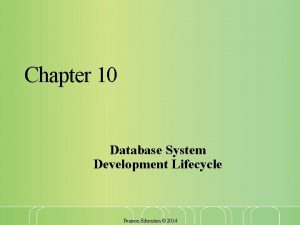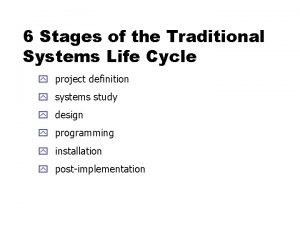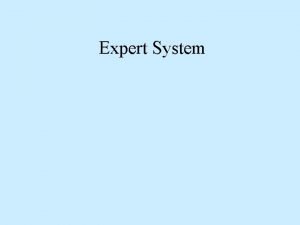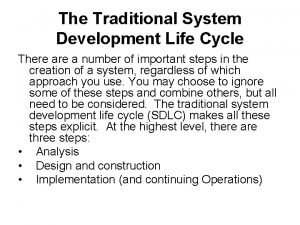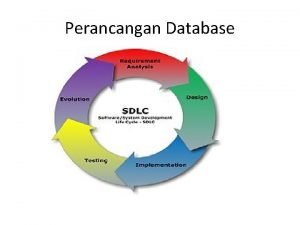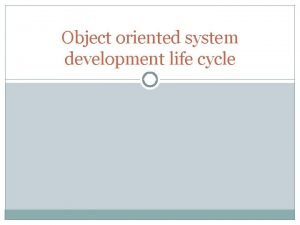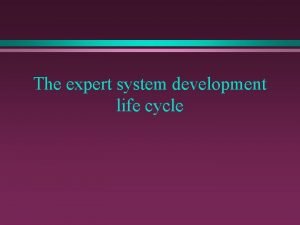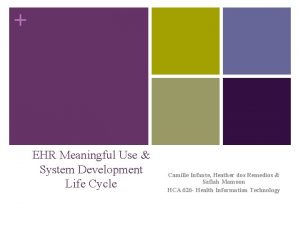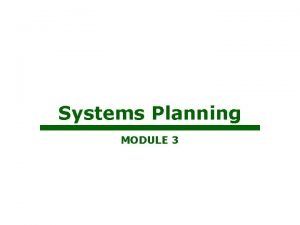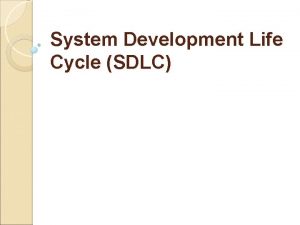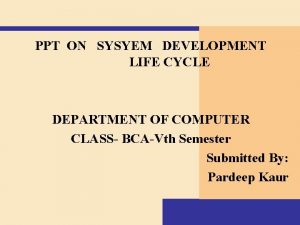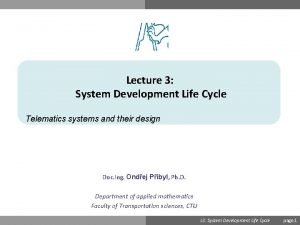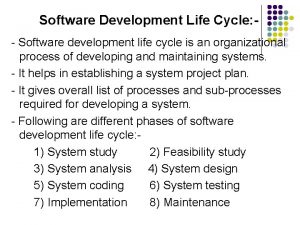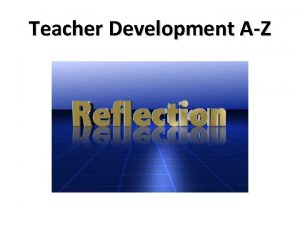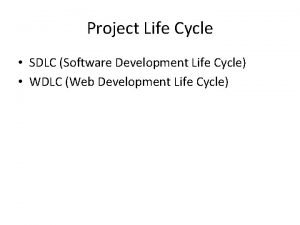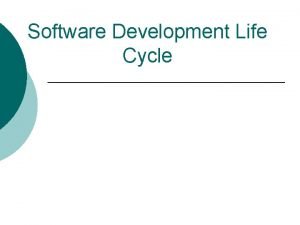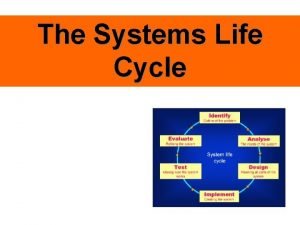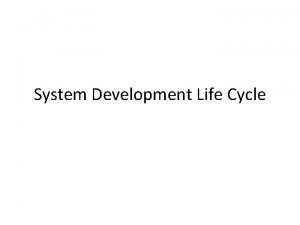Lecture 8 Stages of System Development Life Cycle

















- Slides: 17

Lecture - 8 • Stages of System Development Life Cycle ØProject Selection v. Feasibility Study ØAnalysis ØDesign ØImplementation ØPost – Implementation and Maintenance Wednesday, February 24, 2021

Feasibility Study • A feasibility study – A test of a system proposal according to its workability: • meeting user’s requirements, • effective use of resources and • the cost effectiveness. • It focuses on three major questions: – What are the user’s demonstrable needs and how does a candidate system meet them? – What resources are available for given candidate systems? Is the problem important for solving? – What is the likely impact of the candidate system on the organization? How well does it fit within the organization’s master MIS plan?

Feasibility Study • The objective of feasibility study is not to solve the problem but to acquire a sense of its scope. • During the study, the problem definition is crystallized and aspects of the problem to be included in the system are determined. – Consequently, costs and benefits are estimated with greater accuracy at this stage.

Feasibility Study • Feasibility study is simply a report- – A formal document detailing the nature and scope of the proposed solution. – The proposal summarizes what is known and what is going to be done. • It consists of the following: – – Statement of the problem Summary of findings and recommendations Details of findings Recommendations and conclusions • Management reviews the proposal-> A formal agreement • This is a crucial decision point in the life cycle.

Feasibility Study • Following decision are taken in different feasibility study: – Economic feasibility - The likely benefits outweigh the cost of solving the problem which is generally demonstrated by a cost/ benefit analysis. – Operational feasibility - Whether the problem can be solved in the user’s environment with existing and proposed system workings? – Organizational feasibility – Whether the proposed system is consistent with the organization’s strategic objectives? – Technical feasibility - Whether the problem be solved using existing technology and resources available? – Social feasibility – Whether the problem be solved without causing any social issues? Whether the system will be acceptable to the society?

Lecture - 9 • Stages of System Development Life Cycle ØProject Selection ØFeasibility Study v. Analysis ØDesign ØImplementation ØPost – Implementation and Maintenance Wednesday, February 24, 2021

Analysis • Analysis is a detailed study of the various operations performed by a system and their relationships within and outside of the system. • A key question is, what must be done to solve the problem? • One aspect of analysis is defining the boundaries of the system and determining whether or not a candidate system should consider other related systems. • During analysis, data are collected on the available files, decision points, and transactions handled by the present system.

Analysis Examples of the analysis tools. • Data flow diagrams, • Interviews, • On – site observations, and • Questionnaires

Analysis • The interviews is a commonly used tool in analysis, it requires special skills and sensitivity to the subjects being interviewed. • Training, experience, and common sense are required for collection of the information needed to do the analysis. • Once analysis is completed the analyst has a firm understanding of what is to be done. • The next step is to decide how the problem might be solved. • Thus, in systems design we move from the logical to the physical aspects of the life cycle.

Lecture - 9 • Stages of System Development Life Cycle ØProject Selection ØFeasibility Study ØAnalysis v. Design ØImplementation ØPost – Implementation and Maintenance Wednesday, February 24, 2021

Design • The most creative and challenging phase of the system Development life cycle is system design. • The term design describes a final system and the process by which it is developed. • It refers to the technical specifications (analogous to the engineer’s blueprints) that will be applied in implementing the candidate system. • It also includes the construction of programs and program testing.

Design • The major steps in design – – – The first step is to determine how the output is to be produced and in what format. Samples of the output (and input) are also presented. Second, input data and master files (database) have to be designed to meet the requirements of the proposed output. The operational (processing) phases are handled through program construction and testing • including a list of the programs needed to meet the system’s objectives and complete documentation. � Finally, details related to justification of the system and an estimate of the impact of the candidate system on the user and the organization are documented and evaluated by management as a step toward implementation. � The final report prior to the implementation phase includes procedural flowcharts, record layouts, report layouts, and a workable plan for implementing the candidate system.

Lecture - 9 • Stages of System Development Life Cycle ØProject Selection ØFeasibility Study ØAnalysis ØDesign v. Implementation ØPost – Implementation and Maintenance Wednesday, February 24, 2021

Implementation • The implementation phase is less creative than system design. • It is primarily concerned with user training site preparation, and file conversion. • When the candidate system is linked to terminals or remote sites, the telecommunication network and tests of the network along with the system are also included under implementation. • During the final testing, user acceptance is tested, followed by user training. • Conversion usually takes place at about the same time the user is being trained or later.

Implementation • System testing checks the readiness and accuracy of the system to access, update and retrieve data from new files. • Once the programs become available, test data are read into the computer and processed against the file(s) provided for testing. • If successful, the program(s) is then run with “ live” data. • Otherwise, a diagnostic procedure is used to locate and correct errors in the program.

Lecture - 9 • Stages of System Development Life Cycle ØProject Selection ØFeasibility Study ØAnalysis ØDesign ØImplementation v. Post – Implementation and Maintenance Wednesday, February 24, 2021

Post-Implementation and Maintenance • After implementation, evaluation and maintenance begin. • Like any system there is an aging process that requires periodic maintenance of hardware and software. • If the new information is inconsistent with the design specifications, then changes have to be made. • Hardware also requires periodic maintenance to keep in tune with design specifications. • The importance of maintenance is to continue to bring the new system to standards.
 System development life cycle
System development life cycle Database system development life cycle
Database system development life cycle 6 stages of system life cycle
6 stages of system life cycle Stages of expert system life cycle
Stages of expert system life cycle Traditional systems development life cycle
Traditional systems development life cycle Contoh database system development life cycle
Contoh database system development life cycle Ooad life cycle
Ooad life cycle Embedded software development life cycle
Embedded software development life cycle Life cycle of expert system
Life cycle of expert system System development life cycle of electronic health records
System development life cycle of electronic health records System development life cycle
System development life cycle System development life cycle
System development life cycle System development life cycle ppt
System development life cycle ppt Cross life-cycle activity of system development is
Cross life-cycle activity of system development is Systems analysis and design kendall and kendall
Systems analysis and design kendall and kendall 01:640:244 lecture notes - lecture 15: plat, idah, farad
01:640:244 lecture notes - lecture 15: plat, idah, farad Wolverine's life cycle
Wolverine's life cycle Firefly life cycle
Firefly life cycle

